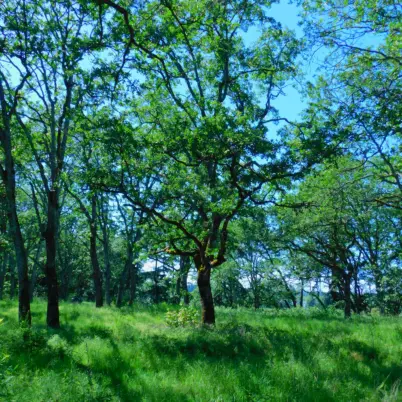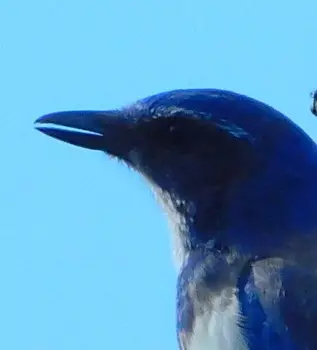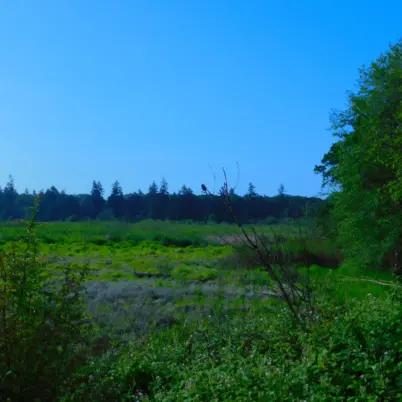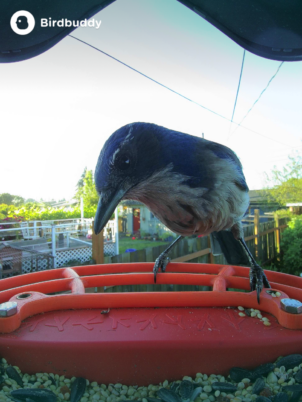The Scrub Jay of South Puget Sound
Living in the Edges: A Survivor Since the Cenozoic
By Marcia Wilson
Note: This bird was split from the Woodhouse’s Scrub-Jay in 2016.

A flash of cerulean blue flits through the rain pools of Building 19. A querulous song greets students in the Outdoor Lab. Osoberries vanish from the marshlands, their seeds found scattered in the open grasslands. In the college marsh, a bright male fights for a choice view of his 25-acre territory. The California scrub jay is not be a long-term native, but it is adapting for an uncertain life further north as their homelands grow less hospitable. Their changeable nature may have begun about 65 million years ago, when the Cenozoic Era saw permanent shifts in geology and climate.
“This is the “blue jay” of parks, neighborhoods, and riverside woods near the Pacific Coast.”
Three generations ago, this bold little bird was an unlikely sight, a “rare permanent resident”. Since the 1970s, they have expanded northward. Lakewood is a good place to see them, almost to the point where one can believe these rare-to-uncommon birds are commonplace.
Grow to Adapt?

The California Scrub Jay’s beak is longer in winter than in the summer.
Why? In summer the favorite food is the large, meaty acorn—especially the native Garry Oak. Oak-reliant jays tend to have shorter beaks with a slight hook at the tip works at getting the meat out of the nut; not too different from how humans use crochet needles as nut-picks when pulling Christmas walnuts out of their shells!
Winter, in contrast, is lower in acorns and the jays may find it easier to stick to a diet of pine nuts, seeds, berries, and small animals. They ravage local birdfeeders, scattering small seed everywhere in search for peanuts. The beaks are thus longer because they are not subjected to so much wear and tear.
Don’t Want No Scrubs?
“The Oak, Willamette Valley, Cowlitz River, and Woodland/Prairie Mosaic zones were core. This jay is peripheral and more local in the Puget Sound Douglas-fir and Western Hemlock zones. Good habitats in all zones were low-to mid-density development, fresh water/wetlands, forest openings and clearings, and hardwood and mixed forests.”—WA Naturemapping Program
Scrub conjures up the image of students on campus in their lab scrubs. Scrubs are the clothing worn in a sterile, a “scrubbed” environment. In the natural world, a “scrubland” is a region dominated by a plant that was once used to manufacture brooms, which were used for scrubbing!
Scrub as a Biome
Scrub biomes are like a desert in that their ecological depths are richer than is obvious to the naked eye. Like an iceberg, there is more going on below the surface of what is observable. Its defining rule is that the dominant vegetation cannot grow higher than 5 meters in height (just over 16 feet) and that gives an impression of low quality or poor, stunted land. Scrublands need a warm, mild and temperate climate (think Mediterranean), and the winters need to be as sopping wet as the summers need to be dry. If this sounds like a typical year in Pierce County, you are not wrong.
Scrublands

The Scotch broom-infested uplands have been called scrublands; so have the long sweeps of Himalaya blackberry fields. Both plants are how “scrublands” got their name, for both were used to make whisks and brooms. Etymology online breaks down scrub as a verb and as a noun:
Verb: c. 1400, scrobben, “to rub hard; rub or scratch (someone, an animal),” a variant of shrubben (c. 1300)… … perhaps from Middle Dutch or Middle Low German schrubben, schrobben “to scrub,” or from an unrecorded Old English cognate of these, or from a Scandinavian source (such as Danish skrubbe “to scrub”). Probably ultimately from the Proto-Germanic root of shrub, an ancient cleaning tool.
Noun: late 14c., “a low, stunted tree; a shrub,” variant of shrobbe, from Old English scrybb, scrub (see shrub, which is the common form of the same word), perhaps influenced by a cognate Scandinavian word (such as Danish dialectal skrub, Old Danish skrubbe, “a stunted tree, brushwood”).
Scrublands are surprisingly rare, but some of the leading regions are (in alphabetical order), the south of Africa, southern Australia, California, Chile, and the Mediterranean. They fascinate scientists as they survived a considerable shift from a much wetter, warmer era. The little jay’s California homeland moved into a harsher world about 65,000,000 years ago. Bit by bit, the summers dried up and the wildlife followed the example of the plants: leave or stay, and should they stay, they needed to adapt or move on to survive.
The swamps and scrublands of Western Washington are a modern-day echo of what the past must have been like. In it, the scrub-jay has thrived.
